Marketing Report: Shopify's Global E-Business and Target Audience
VerifiedAdded on 2023/01/18
|8
|733
|48
Report
AI Summary
This report provides a comprehensive analysis of Shopify's marketing strategies, focusing on identifying the most effective online channels for promoting its products and services. The report begins by defining Shopify's target audience, which includes individuals who spend significant time online and p...
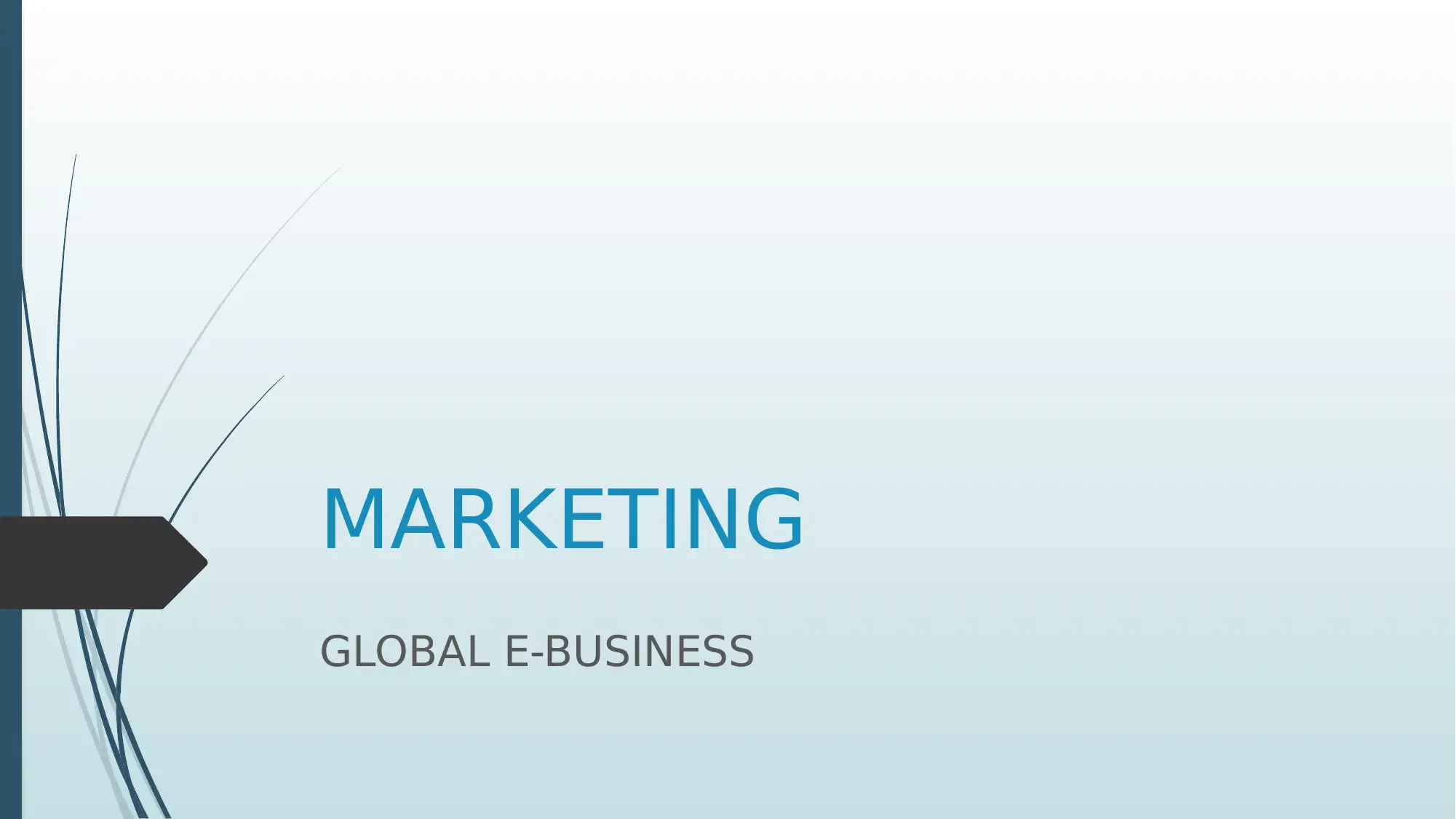
MARKETING
GLOBAL E-BUSINESS
GLOBAL E-BUSINESS
Paraphrase This Document
Need a fresh take? Get an instant paraphrase of this document with our AI Paraphraser
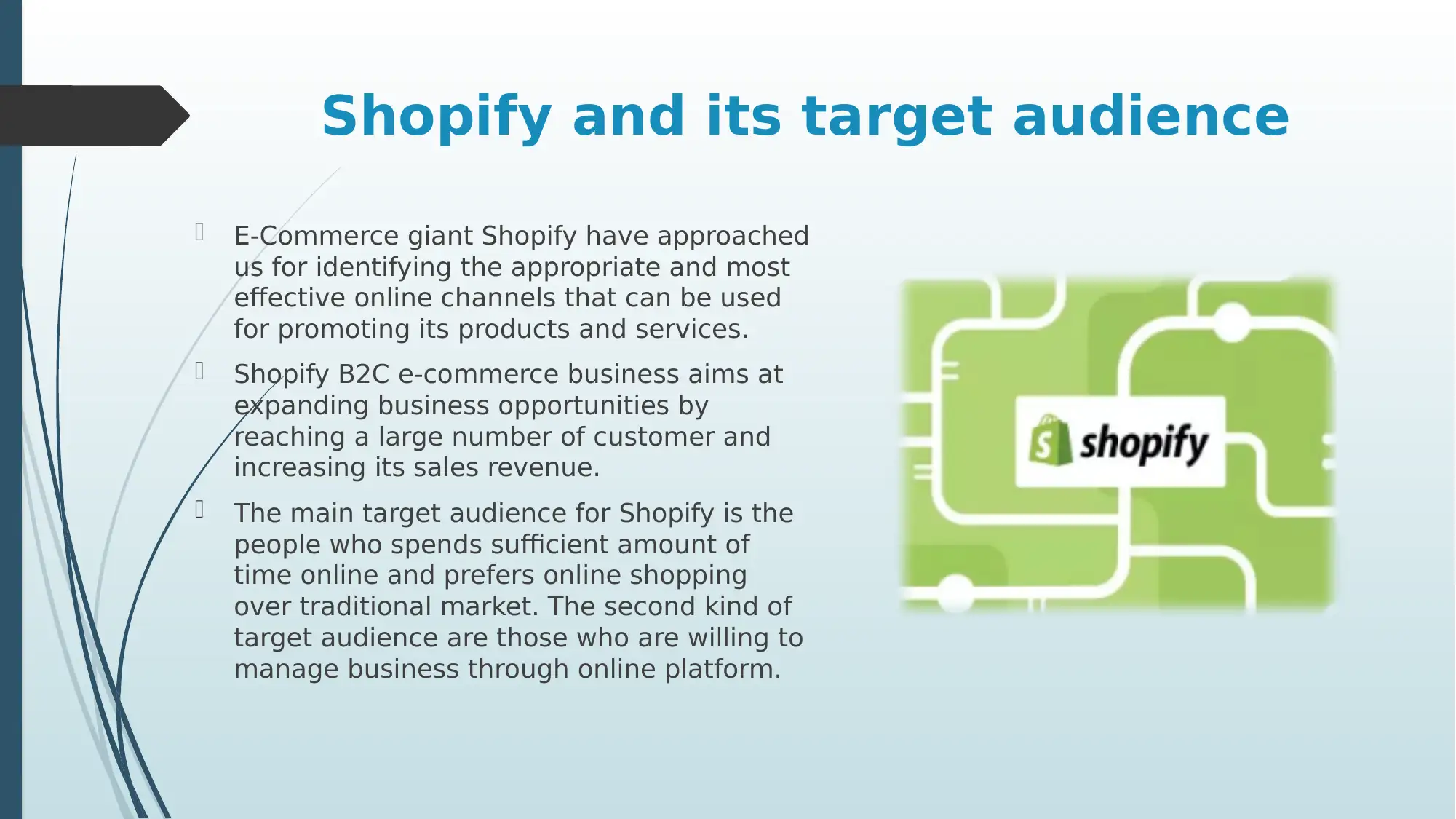
Shopify and its target audience
E-Commerce giant Shopify have approached
us for identifying the appropriate and most
effective online channels that can be used
for promoting its products and services.
Shopify B2C e-commerce business aims at
expanding business opportunities by
reaching a large number of customer and
increasing its sales revenue.
The main target audience for Shopify is the
people who spends sufficient amount of
time online and prefers online shopping
over traditional market. The second kind of
target audience are those who are willing to
manage business through online platform.
E-Commerce giant Shopify have approached
us for identifying the appropriate and most
effective online channels that can be used
for promoting its products and services.
Shopify B2C e-commerce business aims at
expanding business opportunities by
reaching a large number of customer and
increasing its sales revenue.
The main target audience for Shopify is the
people who spends sufficient amount of
time online and prefers online shopping
over traditional market. The second kind of
target audience are those who are willing to
manage business through online platform.

Competition and market
According to the report of Softwares (2018),
Shopify is ranked 3 out of 477 E-commerce
platforms.
The biggest competitors of this e-commerce
company are WooCommerce, Wixstores,
Magneto and Weebly.
The market share of WooCommerce is
28.42% including 1,144,374 number of
website under its business domain (Ashley
and Tuten, 2015).
Similarly Magneto and Wixstores have the
market share of 6.79% with 273,581
websites and 5.56% with 223, 795 websites
respectively (Barger et al. 2016).
According to the report of Softwares (2018),
Shopify is ranked 3 out of 477 E-commerce
platforms.
The biggest competitors of this e-commerce
company are WooCommerce, Wixstores,
Magneto and Weebly.
The market share of WooCommerce is
28.42% including 1,144,374 number of
website under its business domain (Ashley
and Tuten, 2015).
Similarly Magneto and Wixstores have the
market share of 6.79% with 273,581
websites and 5.56% with 223, 795 websites
respectively (Barger et al. 2016).
⊘ This is a preview!⊘
Do you want full access?
Subscribe today to unlock all pages.

Trusted by 1+ million students worldwide
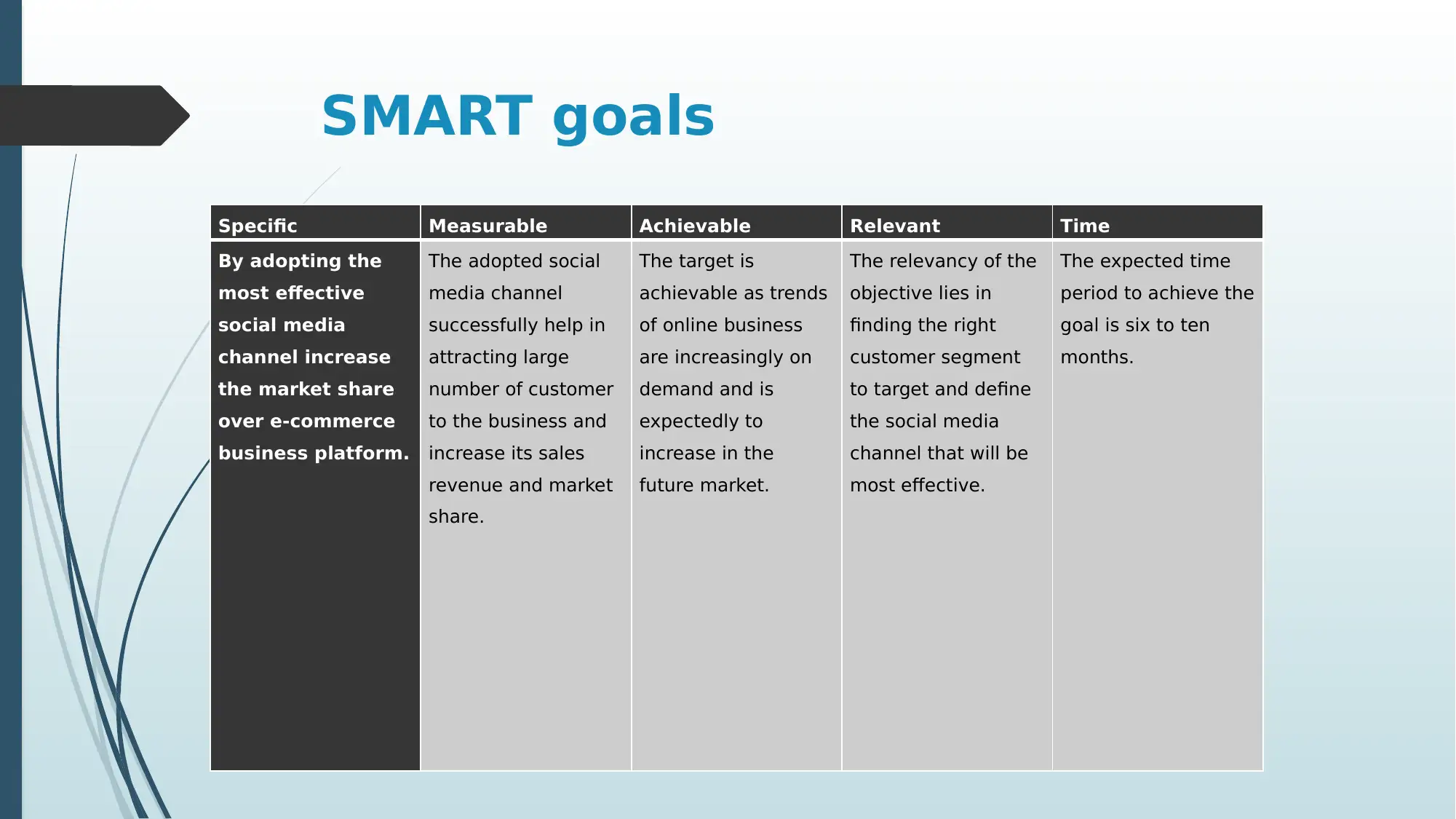
SMART goals
Specific Measurable Achievable Relevant Time
By adopting the
most effective
social media
channel increase
the market share
over e-commerce
business platform.
The adopted social
media channel
successfully help in
attracting large
number of customer
to the business and
increase its sales
revenue and market
share.
The target is
achievable as trends
of online business
are increasingly on
demand and is
expectedly to
increase in the
future market.
The relevancy of the
objective lies in
finding the right
customer segment
to target and define
the social media
channel that will be
most effective.
The expected time
period to achieve the
goal is six to ten
months.
Specific Measurable Achievable Relevant Time
By adopting the
most effective
social media
channel increase
the market share
over e-commerce
business platform.
The adopted social
media channel
successfully help in
attracting large
number of customer
to the business and
increase its sales
revenue and market
share.
The target is
achievable as trends
of online business
are increasingly on
demand and is
expectedly to
increase in the
future market.
The relevancy of the
objective lies in
finding the right
customer segment
to target and define
the social media
channel that will be
most effective.
The expected time
period to achieve the
goal is six to ten
months.
Paraphrase This Document
Need a fresh take? Get an instant paraphrase of this document with our AI Paraphraser
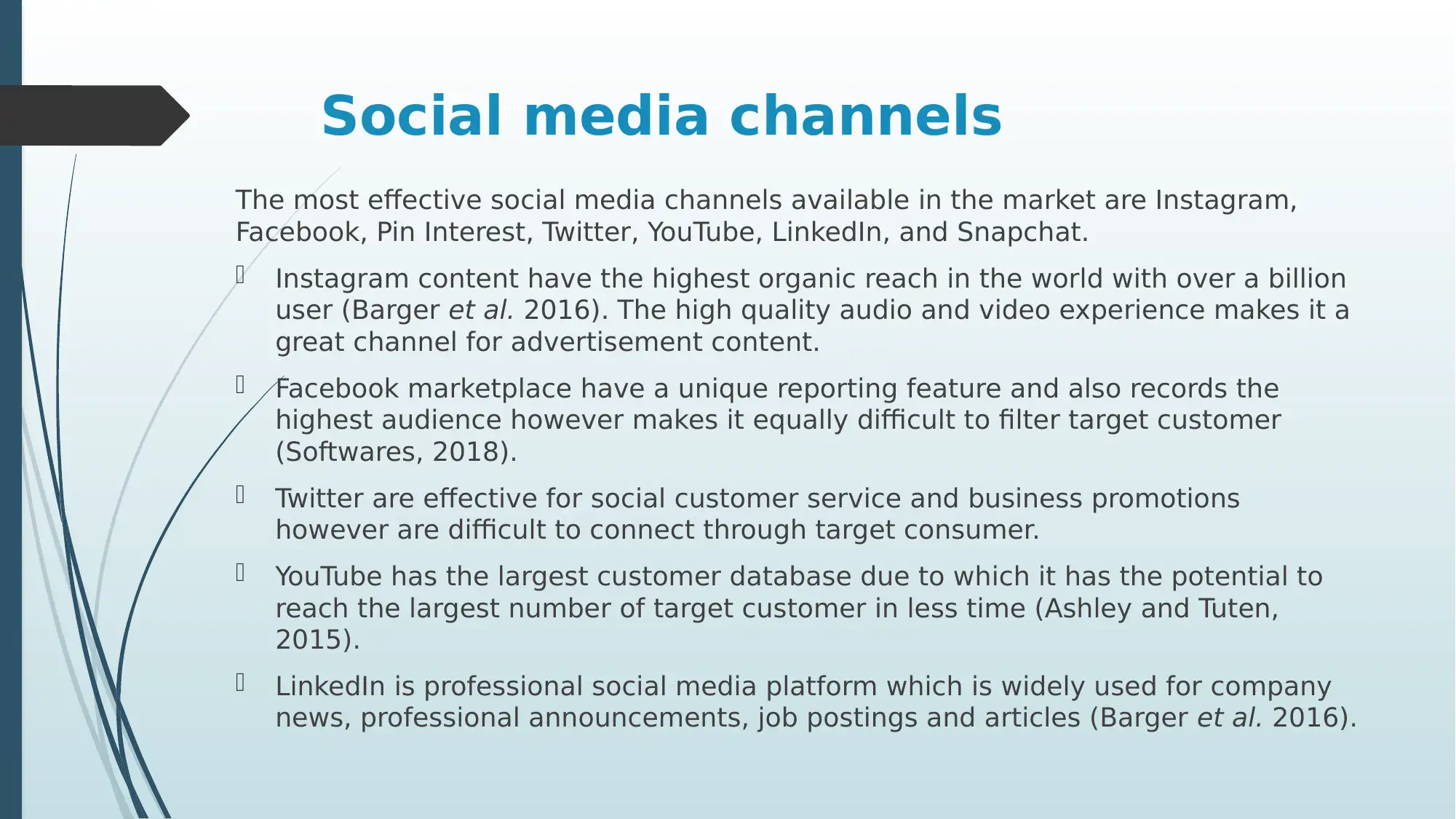
Social media channels
The most effective social media channels available in the market are Instagram,
Facebook, Pin Interest, Twitter, YouTube, LinkedIn, and Snapchat.
Instagram content have the highest organic reach in the world with over a billion
user (Barger et al. 2016). The high quality audio and video experience makes it a
great channel for advertisement content.
Facebook marketplace have a unique reporting feature and also records the
highest audience however makes it equally difficult to filter target customer
(Softwares, 2018).
Twitter are effective for social customer service and business promotions
however are difficult to connect through target consumer.
YouTube has the largest customer database due to which it has the potential to
reach the largest number of target customer in less time (Ashley and Tuten,
2015).
LinkedIn is professional social media platform which is widely used for company
news, professional announcements, job postings and articles (Barger et al. 2016).
The most effective social media channels available in the market are Instagram,
Facebook, Pin Interest, Twitter, YouTube, LinkedIn, and Snapchat.
Instagram content have the highest organic reach in the world with over a billion
user (Barger et al. 2016). The high quality audio and video experience makes it a
great channel for advertisement content.
Facebook marketplace have a unique reporting feature and also records the
highest audience however makes it equally difficult to filter target customer
(Softwares, 2018).
Twitter are effective for social customer service and business promotions
however are difficult to connect through target consumer.
YouTube has the largest customer database due to which it has the potential to
reach the largest number of target customer in less time (Ashley and Tuten,
2015).
LinkedIn is professional social media platform which is widely used for company
news, professional announcements, job postings and articles (Barger et al. 2016).
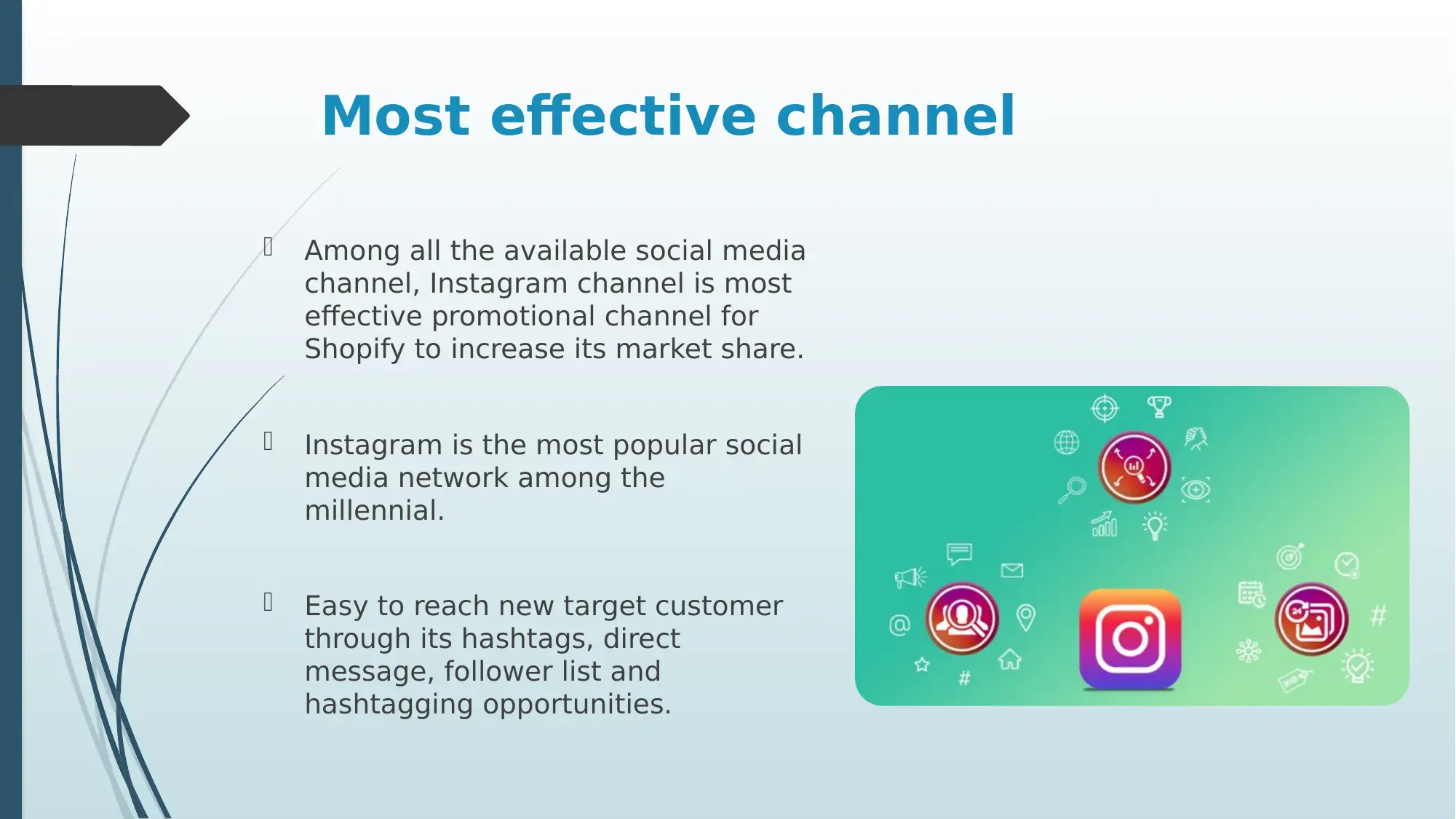
Most effective channel
Among all the available social media
channel, Instagram channel is most
effective promotional channel for
Shopify to increase its market share.
Instagram is the most popular social
media network among the
millennial.
Easy to reach new target customer
through its hashtags, direct
message, follower list and
hashtagging opportunities.
Among all the available social media
channel, Instagram channel is most
effective promotional channel for
Shopify to increase its market share.
Instagram is the most popular social
media network among the
millennial.
Easy to reach new target customer
through its hashtags, direct
message, follower list and
hashtagging opportunities.
⊘ This is a preview!⊘
Do you want full access?
Subscribe today to unlock all pages.

Trusted by 1+ million students worldwide
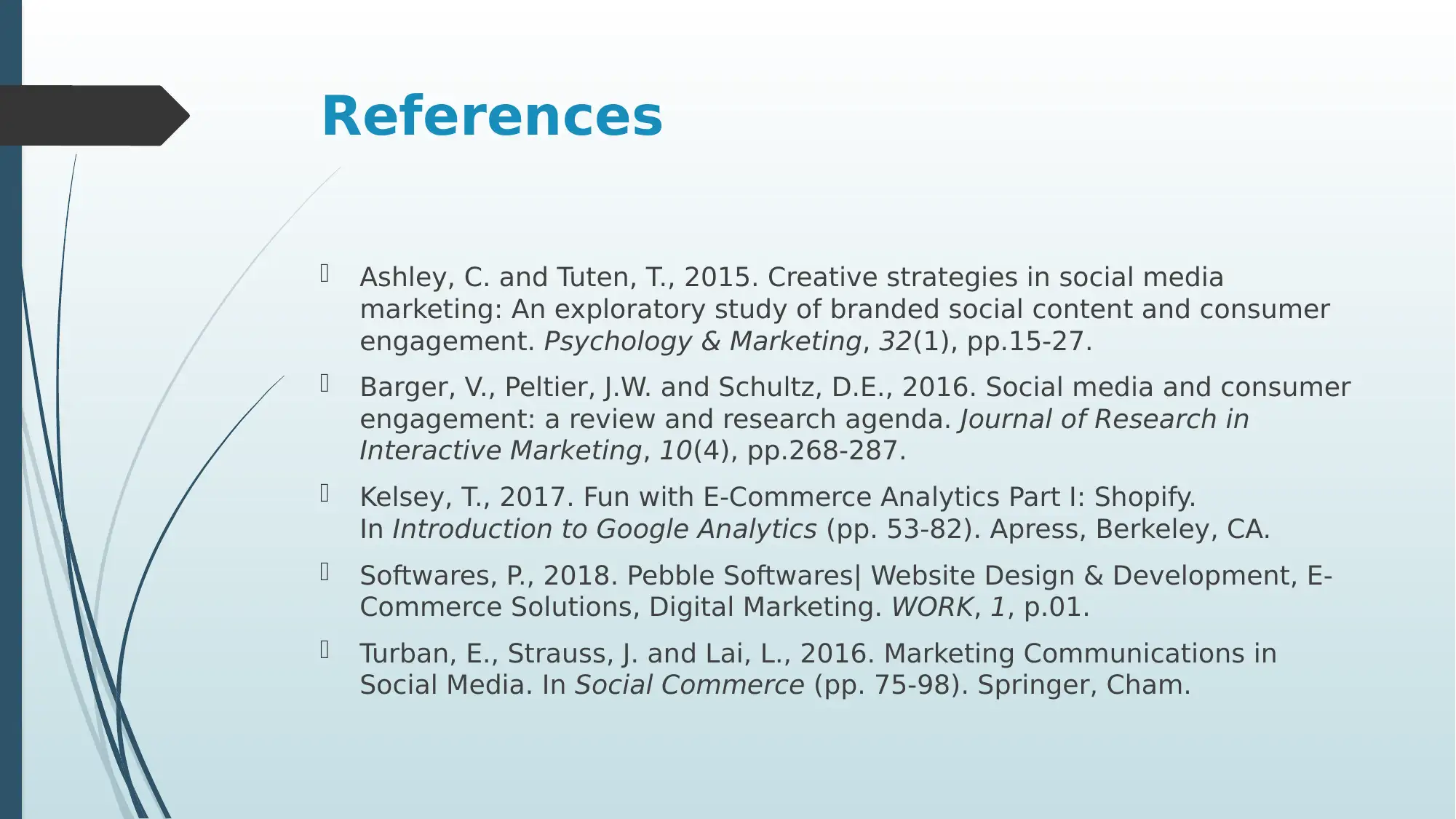
References
Ashley, C. and Tuten, T., 2015. Creative strategies in social media
marketing: An exploratory study of branded social content and consumer
engagement. Psychology & Marketing, 32(1), pp.15-27.
Barger, V., Peltier, J.W. and Schultz, D.E., 2016. Social media and consumer
engagement: a review and research agenda. Journal of Research in
Interactive Marketing, 10(4), pp.268-287.
Kelsey, T., 2017. Fun with E-Commerce Analytics Part I: Shopify.
In Introduction to Google Analytics (pp. 53-82). Apress, Berkeley, CA.
Softwares, P., 2018. Pebble Softwares| Website Design & Development, E-
Commerce Solutions, Digital Marketing. WORK, 1, p.01.
Turban, E., Strauss, J. and Lai, L., 2016. Marketing Communications in
Social Media. In Social Commerce (pp. 75-98). Springer, Cham.
Ashley, C. and Tuten, T., 2015. Creative strategies in social media
marketing: An exploratory study of branded social content and consumer
engagement. Psychology & Marketing, 32(1), pp.15-27.
Barger, V., Peltier, J.W. and Schultz, D.E., 2016. Social media and consumer
engagement: a review and research agenda. Journal of Research in
Interactive Marketing, 10(4), pp.268-287.
Kelsey, T., 2017. Fun with E-Commerce Analytics Part I: Shopify.
In Introduction to Google Analytics (pp. 53-82). Apress, Berkeley, CA.
Softwares, P., 2018. Pebble Softwares| Website Design & Development, E-
Commerce Solutions, Digital Marketing. WORK, 1, p.01.
Turban, E., Strauss, J. and Lai, L., 2016. Marketing Communications in
Social Media. In Social Commerce (pp. 75-98). Springer, Cham.
Paraphrase This Document
Need a fresh take? Get an instant paraphrase of this document with our AI Paraphraser

THANK YOU
1 out of 8
Related Documents
Your All-in-One AI-Powered Toolkit for Academic Success.
+13062052269
info@desklib.com
Available 24*7 on WhatsApp / Email
![[object Object]](/_next/static/media/star-bottom.7253800d.svg)
Unlock your academic potential
© 2024 | Zucol Services PVT LTD | All rights reserved.





